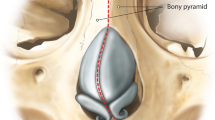Abstract
Prominent ears is the most common congenital malformation in the head and neck region, and over 200 different correction techniques have been published. This demonstrates both the substantial effort devoted to ensuring an harmonious, natural, stable result and the lack of agreement over the approaches to achieve this goal. We present our experience in 42 patients using a combined technique that includes: (a) a large cutaneous excision in the upper part of the helix and in the lobule area to make the ear lie closer to the head, instead of the conventional elliptical excision, (b) closed anterior scoring, according to Stenstrom's technique, to reconstruct the antihelix, possibly combined with Mustardé sutures, (c) removal of the posterior auricular muscle to make the concha fit to the mastoid in a stable way, and (d) a semilunar excision of conchal cartilage by Mustardé's technique if the concha does not fit satisfactorily. This technique has proven to be safe, not particularly difficult to perform, with few complications, and can be used even for very prominent ears with good, stable long-term results.




Similar content being viewed by others
References
Baker DC, Converse JM (1979) Correction of protruding ears: a 20-year retrospective. Aesthetic Plast Surg 3:29–32
Bardach J (1986) Surgery for congenital acquired malformation of the auricle. In: Cummings CW (ed) Otolaryngology: head and neck surgery. Mosby, St. Louis, p 2861
Furnas DW (1968) Correction of prominent ears by concha-mastoid sutures. Plast Reconstr Surg 42:189–193
Graham KE, Gault DT (1997) Endoscopic assisted otoplasty: a preliminary report. Br J Plast Surg 50:47–57
Lavy J, Stearns M (1997) Otoplasty: techniques, results and complications: a review. Clin Otolaryngol 22:390–393
Mustardé JC (1963) The correction of prominent ears using simple mattress sutures. Br J Plast Surg 16:170–176
Mustardé JC (1967) The treatment of prominent ears by buried mattress sutures: a ten years survey. Plast Reconstr Surg 39:382–386
Stenstrom SJ (1963) A "natural" technique for correction of congenitally prominent ears. Plast Reconstr Surg 32:509–518
Tan S, Gault D (1994) When do ears become prominent? Br J Plast Surg 47:573–574
Thomas SS, Fatah F (2001) Closed anterior scoring for prominent-ear correction revisited. Br J Plast Surg 54:581–587
Author information
Authors and Affiliations
Corresponding author
Additional information
An invited commentary to this paper is available at http://dx.doi.org/10.1007/s00238-003-0517-6
Rights and permissions
About this article
Cite this article
Bogetti, P., Boltri, M., Spagnoli, G. et al. Otoplasty for prominent ears with combined techniques. Eur J Plast Surg 26, 144–148 (2003). https://doi.org/10.1007/s00238-003-0516-7
Received:
Accepted:
Published:
Issue Date:
DOI: https://doi.org/10.1007/s00238-003-0516-7




